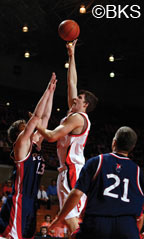
|
April 2, 2008: Sports
Behind the scenes in Boston
Hazen ’98 and Gilula ’98 help to keep the Red Sox in top form
Role reversal
Defense, surprisingly, hampers men’s lacrosse
Sports Scores — Updated weekly
MORE SPORTS ON THE BLOG, click here.
Red Sox executives Mike Hazen ’98, left, and Jonathan Gilula ’98 spoke on the field during spring training in March. (Brita Meng Outzen ’84) |
Behind
the scenes in Boston
Hazen ’98 and Gilula ’98 help to keep the Red Sox
in top form
By David Baumgarten ’06
You’ll have to forgive Mike Hazen ’98 for missing his 10th reunion this spring. As the director of player development for the Boston Red Sox, Hazen oversees the organization’s minor-league system and plays a key role in the team’s preparations for Major League Baseball’s amateur draft, held the first weekend in June. So while his classmates celebrate in Princeton, Hazen will be clocking some of his longest workdays of the year.
In truth, work is a Reunions of sorts for Hazen. Longtime friend Jonathan Gilula ’98, the team’s senior vice president of business affairs, sits just three floors above. And though the P-rade may be one of a kind, the Red Sox championship victory parade last October, which drew hundreds of thousands of fans to the streets of Boston, provided a reasonable alternative.
As Hazen and Gilula are quick to point out, their jobs are, in fact, hard work. Sure, there are the glamorous aspects — the victory parade, the World Series ring, an office connected to Fenway Park by a short hallway — but the Red Sox are a major corporation. “Yes, you’re around professional baseball players,” Hazen said, “but that’s our business.”
Not surprisingly, Hazen and Gilula broke into the business the same way many of their classmates launched careers on Wall Street: with a little help from the Princeton network.
For Gilula, it was Larry Lucchino ’67 who opened the door. While writing his senior thesis on the politics of financing professional sports facilities, Gilula called Lucchino, who recently had become president and CEO of Gilula’s hometown San Diego Padres. Lucchino spent time talking to Gilula about his thesis — and then encouraged him to apply for a job.
Gilula, a two-time All-Ivy League tennis player who had aspired to a career in professional sports, jumped at the opportunity, starting work in the Padres’ ballpark-planning department the day after graduation. Gilula helped the Padres win financing and begin construction on what would become Petco Park, then moved on to Boston in the fall of 2002 after Lucchino became president and CEO of the Red Sox.
Hazen, meanwhile, took the old-school route into baseball, starting as a player. A two-time All-Ivy outfielder, Hazen was drafted in the 31st round by the Padres and played two seasons in the minors before trading in his spikes for a scout’s radar gun. A call from Princeton baseball head coach Scott Bradley helped Hazen land a job working for legendary baseball analyst Peter Gammons, which in turn led to a permanent scouting job with the Cleveland Indians under Mark Shapiro ’89, then the assistant general manager. After Hazen had spent more than five years working his way up the Indians’ organization, the Red Sox hired him to run their farm system in February 2006.
Today, Hazen’s office looks like that of any young corporate executive — laptop and BlackBerry glowing, desk strewn with binders — save for the giant magnetic depth chart on the wall that includes every major- and minor-league player in the Red Sox organization. Being an expert on the strengths and weaknesses of each of the 200 or so names on that board is his job, so Hazen spends much of the season on the road watching and evaluating the Red Sox’ six minor-league teams in person.
On the other hand, watching games is one of the few things Gilula doesn’t do. His job responsibilities include overseeing all off-season physical improvements at Fenway Park and running day-to-day operations at the stadium during the season, so game days are anything but a day at the park. “There’s a lot of troubleshooting, walking around, monitoring the weather,” he explained. “I don’t think I’ve ever sat at Fenway Park and watched a game start to finish.”
Professional responsibilities aside, Hazen and Gilula make it clear they possess the same passion and desire to win as Boston’s fans do. For Hazen, who grew up a Red Sox fan in nearby Abington, Mass., helping his childhood team win is only natural. Gilula may be a more recent immigrant to Red Sox Nation, but he’s assimilated quickly.
“It only takes five minutes once you get your feet on the ground
here to embrace the history and significance of the franchise,”
Gilula said. “The fanaticism of people in this region — you’ve
got to be numb not to feel it.” ![]()
David Baumgarten ’06 is a first-year student at Harvard Law School.

Mark Kovler '09, No. 17, scored four goals against Virginia March 8. (Beverly Schaefer) |
Role
reversal
Defense, surprisingly, hampers men’s lacrosse
By David Marcus ’92
The Princeton men’s lacrosse team saw its offense and defense undergo a surprising role reversal in the season’s first three games. The Tigers scored more goals in a 14–9 loss to Johns Hopkins March 1 and a 12–10 loss to the University of Virginia March 8 than they had in any of their games against the Blue Jays or the Cavaliers since 2002. But in the two losses — and even in a 13–6 win over Canisius Feb. 23 — the Princeton defense bore little resemblance to last year’s unit, which held opponents to an average of 6.17 goals per game, the best in the nation.
The improved offense has come despite the loss of Peter Trombino ’07 and Scott Sowanick ’07, two of Princeton’s top four scorers last year. Before the season, head coach Bill Tierney wasn’t sure who would start on attack, and he has rotated several players on the unit early in the season. His most successful move was putting his best offensive player, midfielder Mark Kovler ’09, on attack against Virginia, where Kovler scored four times. “I’ve been thinking about doing it for two years,” Tierney said of the move. “It’s like coaching in high school: You take your best player and keep him on the field.”
Tierney thought about moving Tommy Davis ’09, who started at attack the last two years, back to his high school position of midfield, but has yet to do so, and Davis has scored six goals and assisted on three others. The coach has used highly recruited attackman Jack McBride ’11 at midfield, and the freshman has responded with three goals and two assists — results that may get him more playing time as the season continues.
It’s a different story on the other side of the ball. Princeton’s defense is giving up more shots than it did last year, more of those shots are on goal, and more are reaching the net. The first two elements of the problem, and even part of the third, reflect the loss of first-team All-American Zachary Jungers ’07 and longstick defensive midfielder John Bennett ’07. Jungers led a defense that limited shots or pressured opponents into taking bad ones, which made goalie Alex Hewit ’08’s job easier. Canisius, Johns Hopkins, and Virginia combined to put 71 of their 115 shots on goal (compared to only 46 of 91 from the same three opponents last year).
Hewit’s save percentage has dipped from 60 percent last year to
55 percent so far this season, in part because of Princeton’s struggles
on defense. “Your confidence does get down when you’re not
playing as well as you know you could,” said Tierney. But, he added,
“We’ve been talking about his mechanics, and he’s the
same guy. It’s not Al’s fault, it’s our defense. We’ve
got to do a better job of giving him shots to save.” ![]()
David Marcus ’92 is a frequent PAW contributor.

|
Zach Finley ’10 |
Center Zach Finley ’10, above, led MEN’S BASKETBALL with 13 points, but the Tigers fell to Penn, 60–47, in their season finale March 11. Princeton beat Columbia March 7 to snap a 9-game losing streak before losing its last two games to Ivy-champion Cornell and the rival Quakers.
Meagan Cowher ’08 scored 31 points in WOMEN’S BASKETBALL’s final game, an 85–78 loss at Penn March 11. Cowher’s career total of 1,671 points ranks second on Princeton’s all-time list.
WOMEN’S SWIMMING won its third consecutive Ivy League championship March 2. Brett Shiflett ’09 capped her Ivy career with wins in the 100- and 200-yard freestyle, and Alicia Aemisegger ’10 was named the meet’s Most Outstanding Swimmer after winning three individual events, including the 1,650-yard freestyle, in which she broke the Ivy record by more than 18 seconds. MEN’S SWIMMING finished second, behind host Harvard, at the Eastern Intercollegiate Swimming League championships March 6–8.
On March 2, WOMEN’S INDOOR TRACK captured its first Ivy League Indoor Heptagonals championship since 1998, edging Brown and Cornell after recording a key win in the 4-by-800-meter relay. MEN’S INDOOR TRACK finished second at the Heps meet, behind host Cornell.
WOMEN’S HOCKEY lost a best-of-three quarterfinal series to No. 9 Clarkson, two games to one, in the ECAC Hockey playoffs Feb. 29–March 2.
Katie Lewis-Lamonica ’08 scored seven of the WOMEN’S
LACROSSE team’s 13 goals in a 13–8 victory over No.
3 Duke March 8. Princeton also beat Johns Hopkins, 7–5, in its season
opener March 1 and topped Rutgers, 16–8, March 5.
![]()



